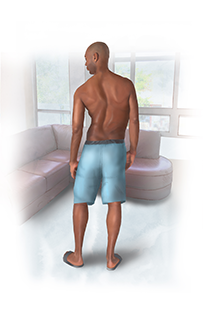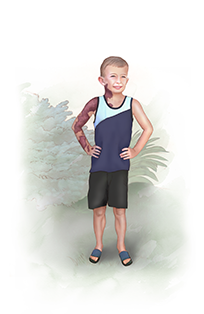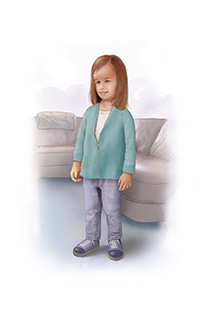
About PROS
Different conditions, one root cause
Many abnormal growth and vascular malformations, including lymphatic conditions, are caused by PIK3CA mutations, meaning that part of the DNA known as the “PIK3CA gene” is abnormal and isn’t working correctly. Because these disorders share this common gene mutation, they were grouped together under the name PIK3CA-Related Overgrowth Spectrum, or “PROS” for short.
You or someone you care for may have been diagnosed recently with one of the following conditions, which may be associated with PIK3CA mutations:
KTS (Klippel-Trenaunay Syndrome)
CLOVES syndrome (Congenital Lipomatous Overgrowth, Vascular malformations, Epidermal nevi, Scoliosis/skeletal and spinal)
ILM (Isolated Lymphatic Malformation)
MCAP or M-CM (Megalencephaly-Capillary Malformation)
HME (HemiMegalEncephaly)/DMEG (Dysplastic MEGalencephaly)/Focal cortical dysplasia type II
HHML (HemiHyperplasia-Multiple Lipomatosis)
FIL (Facial Infiltrating Lipomatosis)
FAVA (FibroAdipose Vascular Anomaly)
Macrodactyly
Muscular HH (HemiHyperplasia)
FAO (FibroAdipose hyperplasia or Overgrowth)
CLAPO syndrome (Capillary malformation of the lower lip, Lymphatic malformation of the face and neck, Asymmetry of the face and limbs, and Partial or generalized Overgrowth)
Epidermal nevus, benign lichenoid keratosis, or seborrheic keratosis
Other conditions may be identified and characterized as PROS. Talk to your doctor to find out if your condition is a PROS condition
Due to the nature of PIK3CA mutations in PROS, a positive mutation status may be difficult to detect. This is because the PIK3CA mutation may not affect all cells in your body. Your doctor may call this mosaicism.
These conditions, which are grouped under the name PROS because all of them are associated with PIK3CA mutations, can look very different from each other in size, shape, and type of growth or malformation. They also may occur in different parts of the body and cause a wide variety of signs and symptoms that can worsen over time. No matter what the symptom, it's important to keep your health care team updated on the status of your condition. To find out more about PROS conditions, click here.
Test your PROS knowledge!
How much do you know about PROS? Take this short quiz to find out.
All PROS conditions have similar features.
Some common features driven by the PIK3CA mutation include:
KTS (Klippel-Trenaunay Syndrome)
CLOVES syndrome (Congenital Lipomatous Overgrowth, Vascular malformations, Epidermal nevi, Scoliosis/skeletal and spinal)
ILM (Isolated Lymphatic Malformation)
MCAP or M-CM (Megalencephaly-Capillary Malformation)
HME (HemiMegalEncephaly)/DMEG (Dysplastic MEGalencephaly)/Focal cortical dysplasia type II
HHML (HemiHyperplasia-Multiple Lipomatosis)
FIL (Facial Infiltrating Lipomatosis)
FAVA (FibroAdipose Vascular Anomaly)
Macrodactyly
Muscular HH (HemiHyperplasia)
FAO (FibroAdipose hyperplasia or Overgrowth)
CLAPO syndrome (Capillary malformation of the lower lip, Lymphatic malformation of the face and neck, Asymmetry of the face and limbs, and Partial or generalized Overgrowth)
Epidermal nevus, benign lichenoid keratosis, or seborrheic keratosis
Other conditions may be identified and characterized as PROS. Talk to your doctor to find out if your condition is a PROS condition






